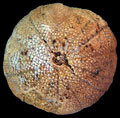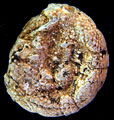Distinguished from the very similar Polycyphus by having uniserial ambulacra. Distinguished from Codiopsis by its ambulacral plating, which is simple acrosaleniid style. In Codiopsis the perradial suture is clearly zig-zaged defining each triad; in Magnosia the median suture is more or less straight.
M. peroni and M. termieri distinguished by having rather tall plates with up to 5 or 6 rows of small equal tubercles. Distinct genus.
M. caraboeufi Cotteau (1880) [Bajocian, France] is based on small individuals, probably too small to have developed the characteristic differences of ambulacra and are best treated as indet.
Magnosia termieri Lambert, 1931 [Bajocian, Morocco], is a Codiopsis. Its interambulacral plates are tall with a dense array of small tubercles, 5-6 deep, not the single row of subequal primaries.
Michelin, H. 1853. Revue et Magazin de Zoologie 5, p. 34.
Mortensen, T. 1935. A monograph of the Echinoidea II. Bothriocidaroida, Melonechinoida, Lepidocentroida and Stirodonta. C. A. Reitzel, Copenhagen.
Smith, A.B. 2011. Gymnodiadema and the Jurassic roots of the Arbacioida (stirodont echinoids). Swiss Journal of Palaeontology 130, 155-171.




